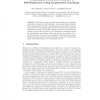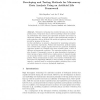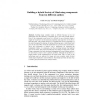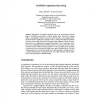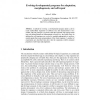ECAL
2003
Springer
15 years 5 months ago
2003
Springer
We present a general method for evaluating and visualizing evolutionary dynamics of self-replicators using a graph-based representation for genealogy. Through a transformation from...
63
Voted
ECAL
2003
Springer
15 years 5 months ago
2003
Springer
ECAL
2003
Springer
15 years 5 months ago
2003
Springer
We demonstrate the evolution of simple embodied Genetic Regulatory Networks (GRNs) as real-time control systems for robotic and software-based embodied Artificial Organisms, and p...
ECAL
2003
Springer
15 years 5 months ago
2003
Springer
An agent-based approach is used to explain the formation of vortex swarms in biological systems. The dynamics of the multiagent system is described by 3N coupled equations, modeli...
76
Voted
ECAL
2003
Springer
15 years 5 months ago
2003
Springer
Building large complex minds is difficult because we do not understand what the necessary components are or how they should interact. Even if the components were known it is diffic...
73
Voted
ECAL
2003
Springer
15 years 5 months ago
2003
Springer
Abstract. We investigate the construction of all the periodic structures or “ gliders ” up to now known in the evolution space of the onedimensional cellular automaton Rule 110...
85
Voted
ECAL
2003
Springer
15 years 5 months ago
2003
Springer
This paper presents an adaptation of Luc Steels’s model of Category Formation and Language Sharing. The simple competitive learning algorithm is proposed as a more general means ...
125
Voted
ECAL
2003
Springer
15 years 5 months ago
2003
Springer
A formal language approach for the specification of ALife models is presented. “Relational Growth Grammars” incorporate rulebased, procedural and object-oriented concepts. By ...
83
Voted
ECAL
2003
Springer
15 years 5 months ago
2003
Springer
Populations of artificial organisms live in an environment in which light is cyclically present (day) or absent (night). Since being active during night is non-adaptive (activity c...
90
Voted
ECAL
2003
Springer
15 years 5 months ago
2003
Springer
A method for evolving a developmental program inside a cell to create multicellular organisms of arbitrary size and characteristics is described. The cell genotype is evolved so th...
